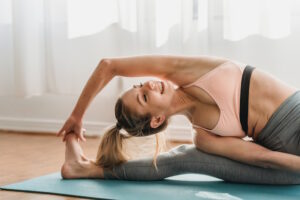
Pilates is a versatile exercise method that can be modified and adapted to accommodate various body types and fitness levels. As a beginner, it’s important to understand that Pilates is not limited to a specific body type, and with the right modifications, everyone can benefit from this transformative practice. In this guide, we will explore the best type of Pilates for beginners, discuss the role of body type in Pilates, explore how Pilates can change your body shape, and provide tips on how to start Pilates as a beginner.
What type of Pilates is best for beginners?
When it comes to Pilates for beginners, it is recommended to start with mat Pilates or beginner-level classes. Mat Pilates focuses on performing exercises on a mat, using your body weight as resistance. Beginner-level classes are designed to introduce newcomers to the foundational principles and exercises of Pilates in a supportive and controlled environment. These classes provide the opportunity to learn proper technique, alignment, and breath control before progressing to more advanced Pilates apparatus such as the reformer or Cadillac.
What body type is needed for Pilates?
Pilates is inclusive and can be adapted for different body types, sizes, and shapes. Pilates is a whole-body exercise method that focuses on developing core strength, flexibility, and overall body awareness. Whether you have a lean, athletic, curvy, or any other body type, Pilates can help you improve posture, build strength, enhance flexibility, and promote overall well-being. The beauty of Pilates lies in its ability to be customized and modified to suit individual needs and abilities.
How can Pilates change your body shape?
Pilates can help transform your body shape in several ways:
1. Improved Posture: Pilates emphasizes proper alignment and postural awareness, which can help correct imbalances and promote better posture. By strengthening the core muscles and aligning the spine, Pilates can contribute to a taller, more elongated appearance.
2. Increased Core Strength: Pilates targets the deep abdominal muscles, back muscles, and pelvic floor, enhancing core strength and stability. This can lead to a toned and defined midsection.
3. Muscle Tone and Definition: Pilates exercises engage and strengthen muscles throughout the body, resulting in improved muscle tone and definition. With consistent practice, you may notice increased strength and lean muscle development.
4. Enhanced Flexibility: Pilates incorporates stretching and lengthening exercises, promoting flexibility and improved range of motion. Increased flexibility can contribute to a more graceful and agile body.
5. Body Awareness and Mind-Body Connection: Pilates promotes body awareness and mindfulness, fostering a deeper connection between the mind and body. This heightened awareness can translate into improved control, coordination, and fluidity of movement.
How do I start Pilates for beginners?
To start Pilates as a beginner, follow these tips:
1. Find a Qualified Instructor: Look for a qualified Pilates instructor who specializes in teaching beginners. An experienced instructor can provide proper guidance, modifications, and adaptations based on your body type and abilities.
2. Begin with Beginner-level Classes: Start with dedicated beginner-level classes or private sessions. These classes are designed to introduce you to the foundational principles and exercises of Pilates, ensuring a solid understanding and execution of the fundamentals.
3. Communicate Your Needs: Inform your instructor about any specific concerns, limitations, or goals you may have. This allows them to provide appropriate modifications and adaptations tailored to your body type and individual needs.
4. Focus on Technique and Alignment: Pay close attention to proper technique, alignment, and breath control during each exercise. Building a strong foundation in the fundamental principles of Pilates will set the stage for safe and effective practice.
5. Progress Gradually: As you gain strength, flexibility, and familiarity with the exercises, gradually progress to more challenging movements and classes. Allow yourself time to adapt and grow in your Pilates practice.
In this comprehensive guide to Pilates for beginners and modifications for various body types, we discussed the best type of Pilates for beginners, emphasizing the importance of starting with mat Pilates or beginner-level classes. We debunked the notion that a specific body type is needed for Pilates, highlighting its inclusivity and adaptability to different body types. Additionally, we explored how Pilates can change your body shape by improving posture, increasing core strength, enhancing muscle tone and definition, promoting flexibility, and fostering body awareness. Lastly, we provided tips on how to start Pilates as a beginner, including finding a qualified instructor, beginning with beginner-level classes, focusing on technique and alignment, and progressing gradually. By following these guidelines, individuals of all body types can embark on a fulfilling Pilates journey that supports their fitness goals and overall well-being.